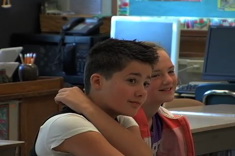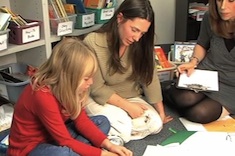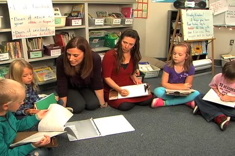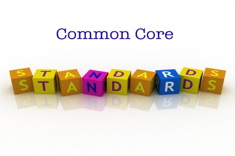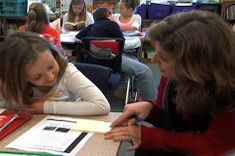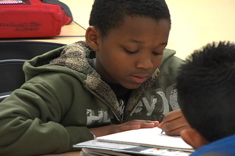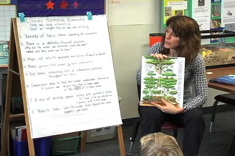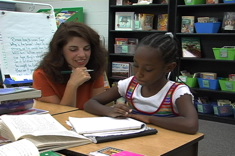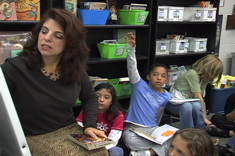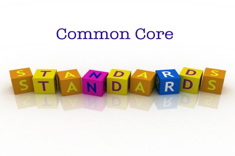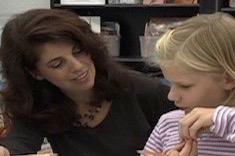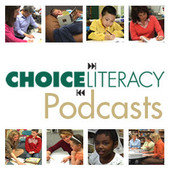Teaching Writing
Everyone who writes for Choice Literacy loves teaching writing, because we all write ourselves. We know it is "hard fun," as Donald Murray famously said—exasperating and exhilarating at the same time. The writing workshops you will read about here and see in our videos are busy, noisy, vibrant places. And most days, we wouldn't want to be anywhere else than in the midst of 'em! Here is where you'll find our latest discoveries, insights, and occasional boneheaded mistakes in teaching writing.
Latest Content
More Productive Writing Share Sessions in First Grade
In this video from a first-grade classroom, Katie DiCesare demonstrates how she has made writing share time more productive by linking student work to recent lessons.
Teaching and Assessing Persuasive Writing Skills
Heather Rader explores different ways into persuasive writing with teachers and students, highlighting the importance of helping students learn to cite and quote expert resources
Scaring Up Better Narratives Part I
Just before Halloween, Aimee Buckner leads a lesson on brainstorming topics in writer's notebooks using the mentor text Some Things Are Scary. In this first installment of a three-part series, Aimee reads the book and models her own thinking process and use of a writer's notebook.
Listen In: Magnifying a Moment in Writing
Sometimes using a prop can help young students understand a revision strategy. Heather Rader helps second-grader Sammi understand how to “magnify” a moment when revising her writing.
Stopping and Jotting
How can we be sure the writing tasks we ask of students are meaningful? Jennifer Jones looks at the issues of authenticity and control when it comes to assigning writing connected to reading in workshops.
Scaring Up Better Narratives Part 2
Just in time for Halloween, Aimee Buckner leads a lesson on brainstorming topics in writer's notebooks using the mentor text Some Things Are Scary. In this second installment of a three-part series, Aimee continues to confer with students and helps everyone refine potential writing topics in their notebooks.
Voila! Best Writing and Entry Slips in Second Grade
The word voila in French literally means “see there.” Linda Karamatic puts time and reflection into creating a binder, or “voila book,” that will ease the bulging writing workshop folders and preserve the best of her second-grade students’ writing.
Frogs as Learning Ambassadors Part 2: Literary Nonfiction in 4th Grade
Andrea Smith explains how the classroom environment influences instruction in the second installment of this video series.
What Can You Learn from Slice of Life Writing?
Ruth Ayres inspires us to develop the habit of writing on a regular basis by taking a bite out of the Slice of Life Story Challenge.
Scaring Up Better Narratives Part 3
Aimee Buckner leads a lesson on brainstorming topics in writer's notebooks using the mentor text Some Things Are Scary. In this final installment of a three-part series, Aimee continues to confer with students and shares a great tip for nonfiction research.
The Sponge Summary Lesson Part 1
In this sequence of videos, Heather teaches a fourth-grade class, using the analogy of a sponge to explain how summaries work. In this first video excerpt, Heather reviews the work the class has already done on understanding the attributes of good summaries.
Argumentative, Opinion, and Persuasive Writing in the Common Core
What does the Common Core have to say about persuasive writing? Jennifer Burton explains how she and her colleagues are teasing out the differences between opinion, argument, and persuasive writing with students, and helping them develop this type of writing in authentic ways
Main Ideas, Summaries, and Notes in a Reading Conference
In this conference with a fourth grader, Aimee Buckner tackles text choice, notes, and main ideas all in less than five minutes. You’ll notice teachers observing in the background; the conference is part of a demonstration lesson sequence.
The Sponge Summary Lesson Part 2
In this sequence of videos, Heather teaches a fourth-grade class, using the analogy of a sponge to explain how summaries work. In this second video, Heather presents the powerful analogy of a sponge for summarizing.
The Sponge Summary Lesson Part 3
In this sequence of videos, Heather teaches a 4th grade class, using the analogy of a sponge to explain how summaries work. In this third video, Heather and students cull down a text into the important points needed for a summary.
The Sponge Summary Lesson Part 4
In this sequence of videos, Heather Rader teaches a 4th grade class, using the analogy of a sponge to explain how summaries work. In this fourth video, Heather and students discuss their summaries in progress
“School” Writing at the End of the Year
Writing about education is important in Erin Ocon's middle school classroom. Although Erin's students are in the eighth grade, this is a terrific project for readers of any age, and could even be used schoolwide for closure and celebration.
Learning to Write Engaging Nonfiction: A Middle School Partner Writing Study
Ann Marie Corgill takes a big risk and pairs her middle-school students randomly for a nonfiction writing project, and finds the risk pays off.
Digging Into Literary Nonfiction
Andrea Smith and her 4th grade students use an article from National Geographic for Kids to chart literary nonfiction elements.
Preparing Students for Summer Reading (ROUND-UP)
This round-up includes suggestions from Choice Literacy contributors Julie Johnson, Beth Lawson, Cathy Mere, Donalyn Miller, Colby Sharp, and Karen Terlecky.
Best Practices in Spelling Instruction
Heather Rader wades through the research to find the best practices in spelling instruction.
Three Rules Worthy of Spelling Inquiry
It seems like every spelling rule has an exception — so which ones must be taught? Heather Rader shares the three spelling rules worth any teacher’s time.
Classroom Changes and Birdhouse Gourds
Andrea Smith reworks a board that was successful in the past but is woefully empty now.
Writing Better First Drafts
Aimee Buckner uses her love of baking to make the point that creating better first drafts is key to stronger writing and more enjoyment in the revising phase.
Mentor Texts for a Writing Study in Graphica
Graphica readers often want to become graphica writers. Franki Sibberson weeds through the books and leaves us with the "good stuff" for mentor texts.
Preserving Student Writing as a Curator
Once students are producing quality writing, there is a new challenge: what to do with it all? Heather Rader works with a teacher to design a system to meet her needs.
Making the Reading-Writing Connection with Genre Studies: The “Must Have” Lesson
No stranger to genre studies, Aimee Buckner has both advice and book basket ideas to get must-haves in your hands.
Common Core Conversations: Reading in the Disciplines
Amanda Adrian and Heather Rader look at reading across the disciplines within the Common Core.
Mentor Texts for Organizing Writing
We think of mentor texts for teaching literary elements, but what about for organizing? Aimee Buckner describes how she selects books to demonstrate a range of ways to organize writing and help students make choices independently.
Finding Time for Your Writing with Ruth Ayres (PODCAST)
In this podcast, Ruth Ayres is no stranger to working hard to find time to write, but that’s why it’s important that we do.
Browse Content By
Type
Category
- Assessment Tools
- Big Fresh Archives
- Booklists
- Choice Numeracy
- Classroom Design
- Common Core
- Community Building
- Conferring
- Content Literacy
- Digital Literacy
- English Language Learners
- Equity
- Family Relations
- Free Samples
- Guiding Groups
- Leadership
- Literacy Coaches
- Mentor Texts
- Minilessons
- New Teacher Mentors
- Podcasts
- Poetry
- Quote Collections
- Reading Strategies
- Self Care
- Struggling and Striving Learners
- Talking and Listening
- Teacher Study Groups
- Teaching Reading
- Teaching Writing
- Word Study and Vocabulary
Author
- Melissa Quimby
- Nawal Qarooni
- Gwen Blumberg
- Julie Cox
- The Lead Learners
- Hannah Tills
- Josie Stewart
- Ruth Metcalfe
- Mallory Messenger
- Becca Burk
- Jodie Bailey
- Vivian Chen
- Mary Brower
- Tiffany Abbott Fuller
- Stephanie Affinito
- Ruth Ayres
- Leigh Anne Eck
- Heather Fisher
- Shari Frost
- Julie Johnson
- Suzy Kaback
- Gigi McAllister
- Shirl McPhillips
- Melanie Meehan
- Cathy Mere
- Debbie Miller
- Tara Barnett and Kate Mills
- Tammy Mulligan
- Dana Murphy
- Bitsy Parks
- David Pittman
- Brenda Power
- Heather Rader
- Matt Renwick
- Mandy Robek
- Christy Rush-Levine
- Gretchen Schroeder
- Jen Schwanke
- Brian Sepe
- Katherine Sokolowski
- Stella Villalba
- Jennifer Vincent
Grade Level
Choice Literacy Membership
Articles
Get full access to all Choice Literacy article content
Videos
Get full access to all Choice Literacy video content
Courses
Access Choice Literacy course curriculum and training



